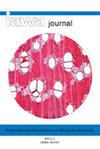墨西哥北部圣卡洛斯组(上白垩纪)的新双子叶植物木材
IF 1.4
3区 农林科学
Q2 FORESTRY
引用次数: 1
摘要
我们描述了墨西哥奇瓦瓦州圣卡洛斯组(上白垩纪)的两个新的木材化石。第一种木材类似于Metcalfeoxion化石属,具有孤立的血管、梯状穿孔板、与血管间凹坑大小相似的血管射线薄壁组织凹坑、轴向薄壁组织在气管外扩散和聚集体中扩散,以及具有长的单列尾的异细胞多变量射线。第二种木材是一个新的化石属,其特征是具有弥漫的多孔木材,导管主要是单生的,导管轮廓为椭圆形并倾向于两个直径类别,简单的穿孔板,微小的交替的导管间凹坑,大小和形状类似于管间凹坑的导管射线薄壁组织凹坑,以及仅单列和双列射线。这种特征的结合支持了它在Myrtales(?Myrtaceae)中的位置,在一个名为Lazarocadenosxylon的新化石属中。这两项新记录提供了更多关于圣卡洛斯组晚白垩世植物区系组成及其与美国南部植物区系关系的信息。然而,墨西哥北部和美国南部这些白垩纪植物区系的确切关系仍然难以确定。本文章由计算机程序翻译,如有差异,请以英文原文为准。
New dicotyledonous woods from the San Carlos Formation (Upper Cretaceous) in Northern Mexico
We describe two new fossil woods from the San Carlos Formation (Upper Cretaceous), Chihuahua State, Mexico. The first wood resembles the fossil genus Metcalfeoxylon in having solitary vessels, scalariform perforation plates, vessel-ray parenchyma pits of similar size as the intervessel pits, axial parenchyma apotracheal diffuse and diffuse in aggregates, and heterocellular multiseriate rays with long, uniseriate tails. The second wood is a new fossil genus, and it is characterized by having diffuse porous wood, vessels predominantly solitary, vessel outlines oval and tending to be of two diameter classes, simple perforation plates, minute alternate intervessel pits, vessel-ray parenchyma pits similar to intervessel pits in size and shape, vasicentric tracheids, non-septate fibers, homocellular rays, and exclusively uniseriate and biseriate rays. This combination of features supports its placement in Myrtales (?Myrtaceae), in a new fossil-genus named Lazarocardenasoxylon. These two new records provide more information about the floristic composition of the Late Cretaceous flora of the San Carlos Formation and its relationship with those from the southern USA. However, a definitive picture of the floristic relationship of these Cretaceous floras of northern Mexico and southern USA remains elusive.
求助全文
通过发布文献求助,成功后即可免费获取论文全文。
去求助
来源期刊

IAWA Journal
农林科学-林学
CiteScore
3.40
自引率
15.80%
发文量
26
审稿时长
>36 weeks
期刊介绍:
The IAWA Journal is the only international periodical fully devoted to structure, function, identification and utilisation of wood and bark in trees, shrubs, lianas, palms, bamboo and herbs. Many papers are of a multidisciplinary nature, linking
 求助内容:
求助内容: 应助结果提醒方式:
应助结果提醒方式:


